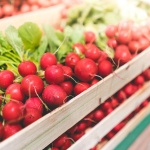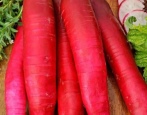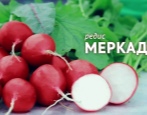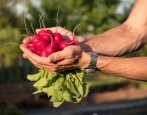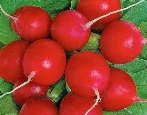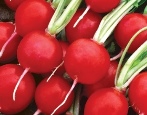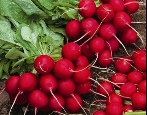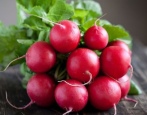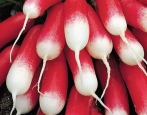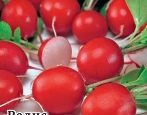
- Authors: Blokin-Mechtalin V.I.
- Year of approval: 2020
- Ripening terms: early maturing
- Leaf rosette shape: semi-upright
- Leaves: medium length, obovate with rounded apex, grayish green
- Petiole: with anthocyanin coloration
- The form: rounded
- Coloration: raspberry pink
- Weight, g: 27-30
- Color of the pulp: white, opaque
Dusya radish is an early maturing universal variety. It is an active plant with a compact rosette and excellent tasting ball fruits.
Description of the variety
Dusya radish was bred by Vasily Ivanovich Blokin-Mechtalin, a famous originator who has already created many varieties of popular garden crops. All of its varieties meet the requirements of the modern gardener who wants to see productive, hardy plants with a twist. The variety was included in the State Register in 2020.
Characteristics of the appearance of the plant and root crops
The rosette is small, with sturdy petioles and medium-sized leaf blades. Slightly spreading. Petioles and leaves are light green.
Root crops are ideally round, raspberry-pink in color, medium-sized - 27-30 grams. Diameter 2.5-3 cm. The tail is crimson with a white tip. The pulp is snow-white, dense, juicy, very even. The fruits lie perfectly, are not prone to flabbiness and the formation of voids, look great in bunches.
Purpose and taste of tubers
The taste is semi-sharp, without bitterness, aromatic, fresh and sweet. The flesh is of excellent consistency: crispy, firm, fleshy, yet tender. The fruits are intended for fresh consumption, suitable for children's and dietetic cuisine.
Maturation
The hybrid is early ripe, ripens 3 weeks (23-25 days) after the emergence of mass shoots. With careful agricultural technology, you can get fruits earlier - after 16 days, including on the windowsill.
Yield
The yield is excellent, at the level of modern varieties - an average of 3.2-3.6 kg per 1 sq. m. Even 3 kg is considered a high indicator for a crop.
Growing regions
Radish is an unpretentious and cold-resistant crop. It is grown in all regions of the Russian Federation. The Dusya variety is recommended for cultivation throughout Russia, in any conditions: open ground, indoor. You can grow it on a balcony or windowsill.
Growing and care
The variety is intended for cultivation in private household plots.
Sowing density - 200-220 seeds per 1 sq. m. Scheme - every 5 cm, in row spacings - 10 cm each.
Before sowing radish, the soil is shed with "Fitosporin", this preparation will protect young seedlings from diseases. The seeds are soaked in stimulants "Epin", "Zircon", "Suspension of Chlorella". Prepared seeds will sprout 4-5 days earlier than dry seeds - after 3-4 days.
You can sow every 2 weeks until September.
Radishes usually require thinning. The Dusya variety was deliberately bred so as to bring the gardener as little trouble as possible. Its roots are not too large, so they quickly grow to the desired size, even with a slight thickening.
Like any radish, the cultivar loves abundant watering. Dry soil provokes a coarsening of the pulp, the appearance of arrows. Radishes can start to taste very bitter. In the right soil, there is no risk of overflowing the plant. It is advisable to water the radish daily, even better - 2 times a day, morning and evening.
Radishes are rarely mulched, but if there is no time to follow the watering, you can use a thin cover, 1 cm, of dry peat, chopped grass or straw.
Early maturing varieties of radish do not need additional fertilizing. But if the soil is poor, you can apply a complex mineral fertilizer for vegetables during the period of root thickening (2 weeks after germination). The fertilizer should focus on potassium and phosphorus content.
Ash is very useful, it contains the whole complex of essential minerals, a minimum of nitrogen and reduces the acidity of the soil.Radish is watered with ash infusion or leaves are powdered with ash.
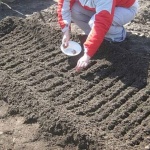

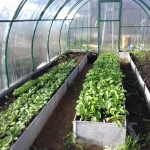
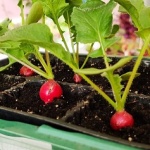
Soil requirements
The soil for radishes should be soft, light, moisture-retaining and breathable. Fertility is above average. Poor soil is dug up with compost (from 0.5 to 2 buckets per 1 sq. M). The use of fresh manure is unacceptable - with an excess of nitrogen, the radish begins to go into the "tops", the roots will be small and tasteless. Further agricultural technology depends on the looseness of the soil. In airborne soil for Dusya radish, you can not thin out - all the fruits will be of the stated size.
Radishes do not like sour soils, the acidity should be medium. Chalk, dolomite flour or slaked lime are introduced. During the growing period, it will be useful to feed the radishes with a solution of chalk and herbal infusion, especially if the plants are growing slowly.
Required climatic conditions
Radish is a cold-resistant culture, the optimal temperature range during the growing period is + 15 ... 18 ° С. Seeds germinate at a temperature of + 3 ... 4 ° C. For young seedlings, the ideal range is + 12… 16 ° С. Radish can withstand temperatures as low as –3 ° С.
The variety Dusya has not yet collected enough reviews. A few reviews have shown that Dusya is an early and reliable hybrid. The fruits are impressive. Smooth, very juicy, abundant, suitable for thickened crops (good for those who do not want to waste time thinning radishes). A hybrid is worth considering for those looking for the earliest variety suitable for experimentation and trial.

